The Legend of Lois Jordan’s White Angel Jungle
Thoughts on a famous San Francisco soup kitchen.
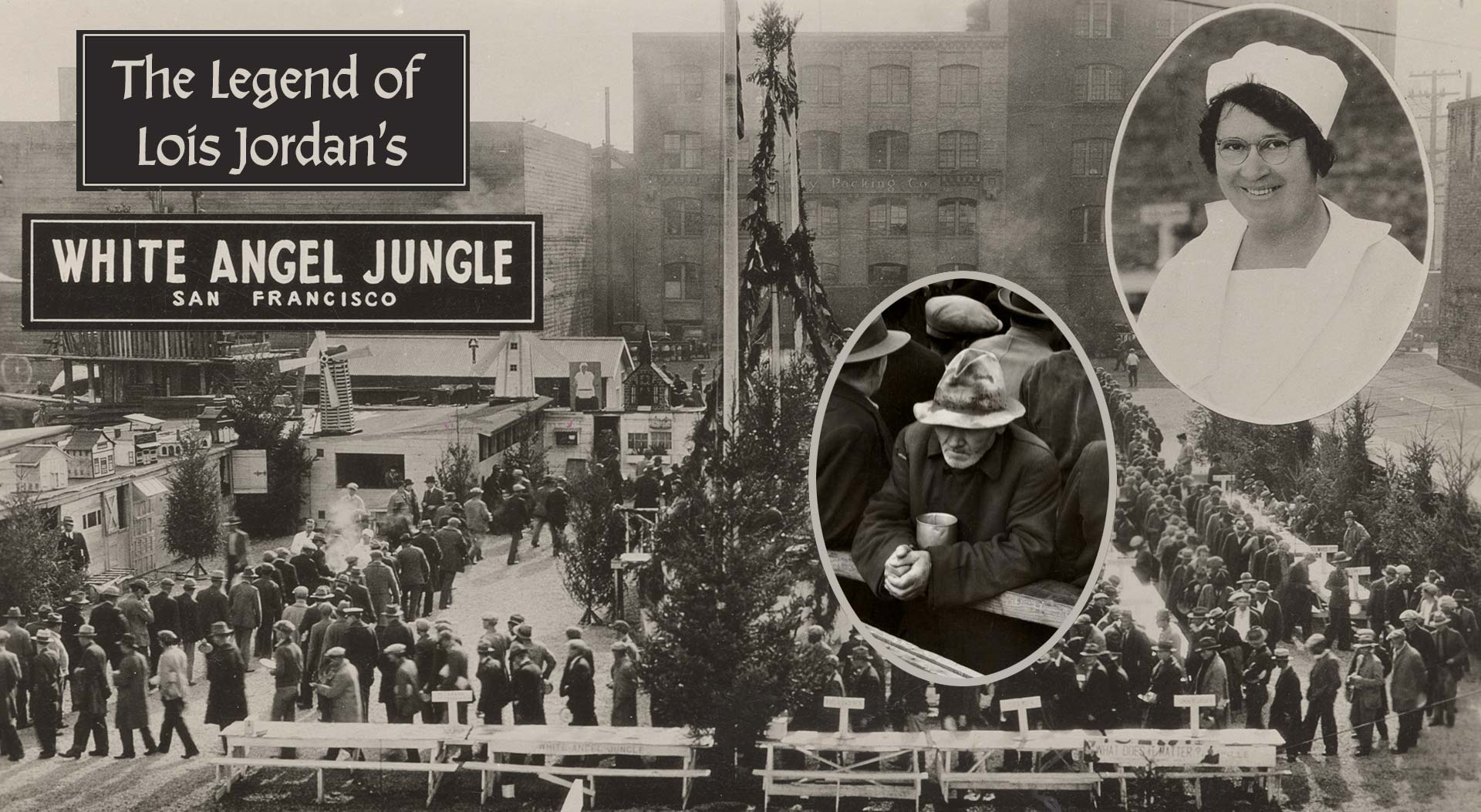
The short story: in the depths of the Great Depression a remarkable woman set up her own open-air soup kitchen to feed unemployed men at San Francisco’s Embarcadero.
With a cheerful can-do attitude, Jordan ladled out soup and distributed donated clothes to the needy “regardless of color, creed, race or state.” News of her work at the junk lot she called “White Angel Jungle” spread across the country.
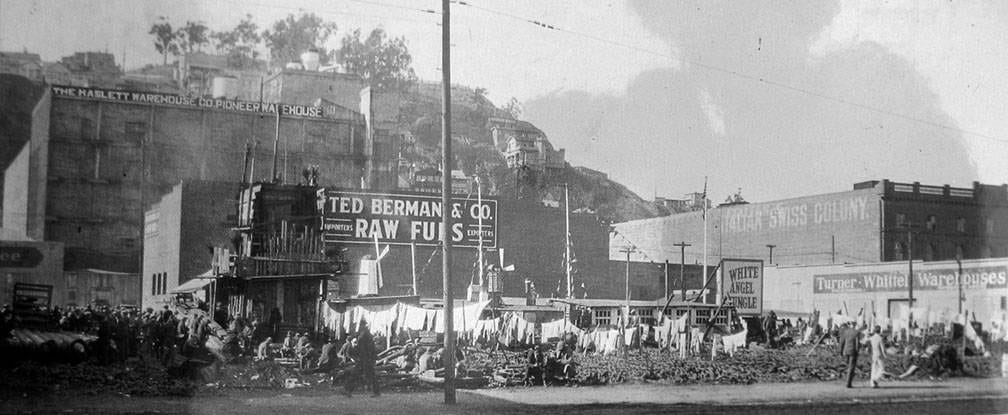
There are two iconic Dorothea Lange photos of the Great Depression, images that every high school child sees in their history books. (Are there still high school history books?). One was taken at the White Angel Jungle:

That’s the short story. Gary Kamiya wrote an excellent piece on White Angel Jungle in 2021 for Alta magazine. My friend John Freeman researched Jordan and her murky back story in 2008 (see a PDF link in the sources below). Many places, including the Kennedy Center, have written about the Lange photograph, with varying degrees of accuracy on “White Angel Jungle.”
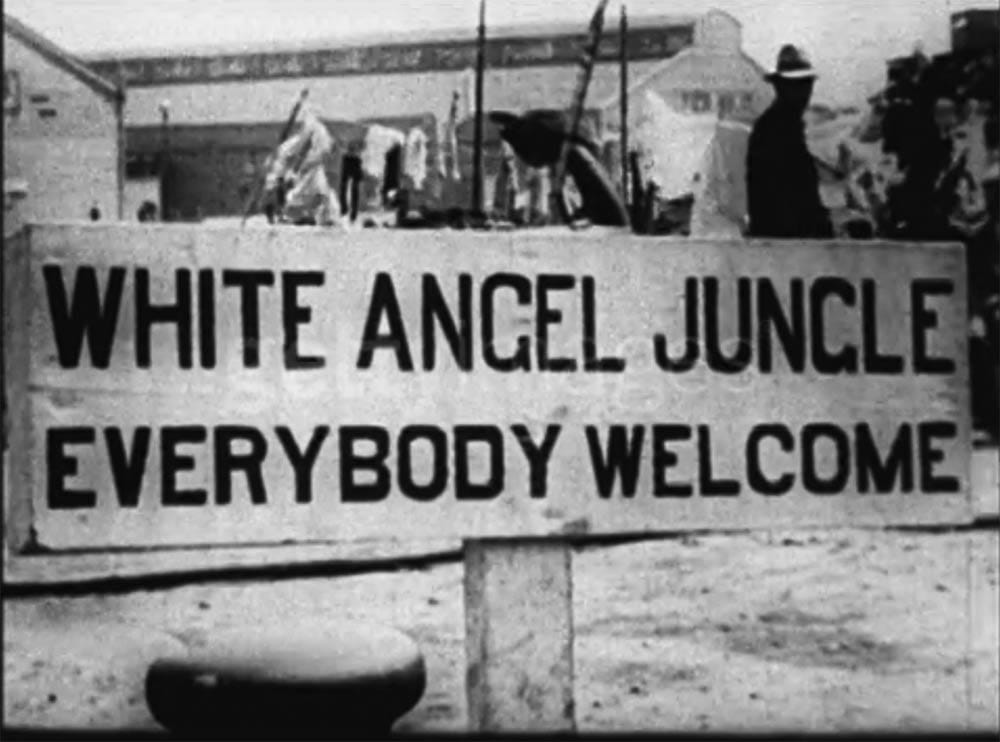
Stories are distilled, saved, and shared because they have a point: to amuse, inspire, persuade. They survive and become legends when they resonate and can be used as tools in the present time.

Thanks in part to the genius of Dorothea Lange, and the ongoing appreciation of her work, the story of White Angel Jungle has mostly been “this was the Great Depression.” Poverty, deprivation, despair, want.
But one doesn’t think of those words seeing postcard images of White Angel Jungle:
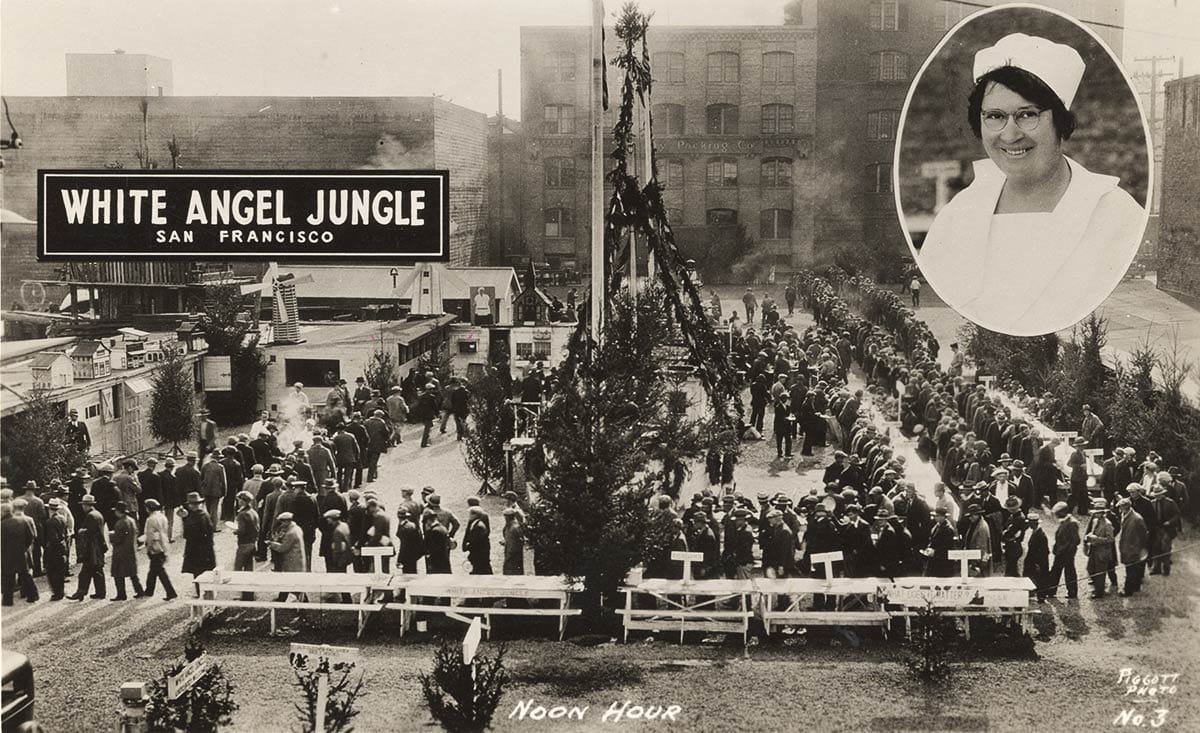
When I use “legend” in the title of this post, I don’t mean that Lois Jordan didn’t exist, or that her creation of White Angel Jungle wasn’t charitable, inspirational, or run with integrity. I am intrigued by her own story-making.
“I saw the White Angel,” wrote Terry Donoghue, a writer on the bum for the Buffalo Times. “She was dressed in a white uniform, a short, fat figure; a gleaming red face from which sharp eyes glanced through large glasses.”
Jordan told a reporter she didn’t like being called the White Angel, but she certainly played the part with her snowy nurse’s uniform and her double-handed ladling:
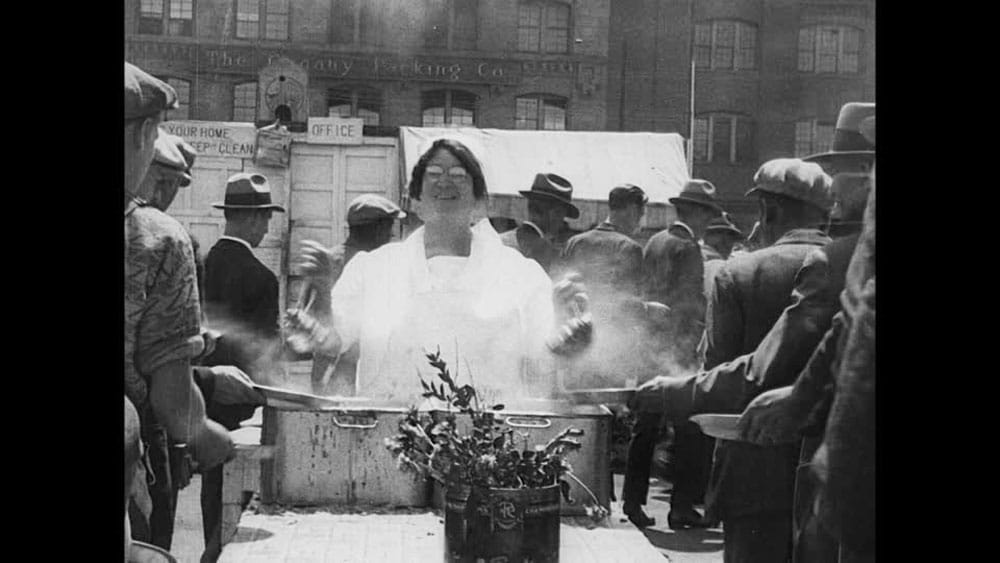
Jordan’s apparent joy at what she’s doing shines through everything. Watch some old newsreel and her energy almost puts color into the black and white film.
She leaned into the stagecraft. Check out the garland-draped, landlocked boat with the flagpole:
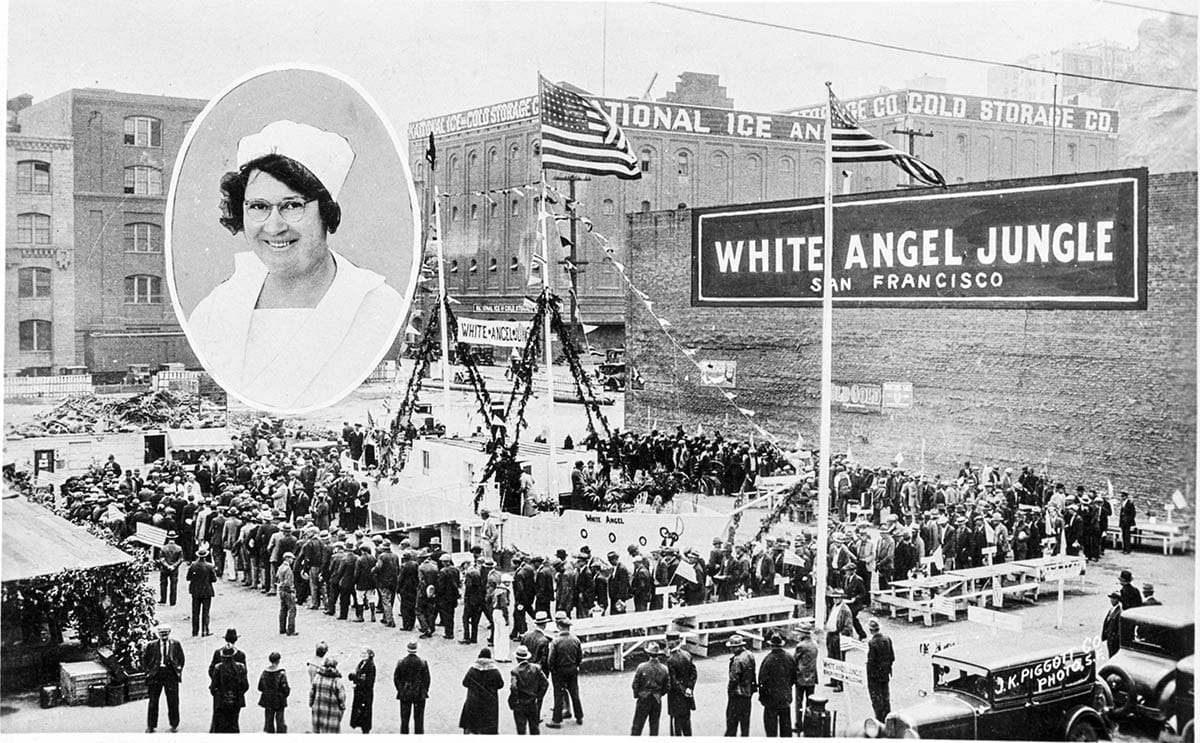
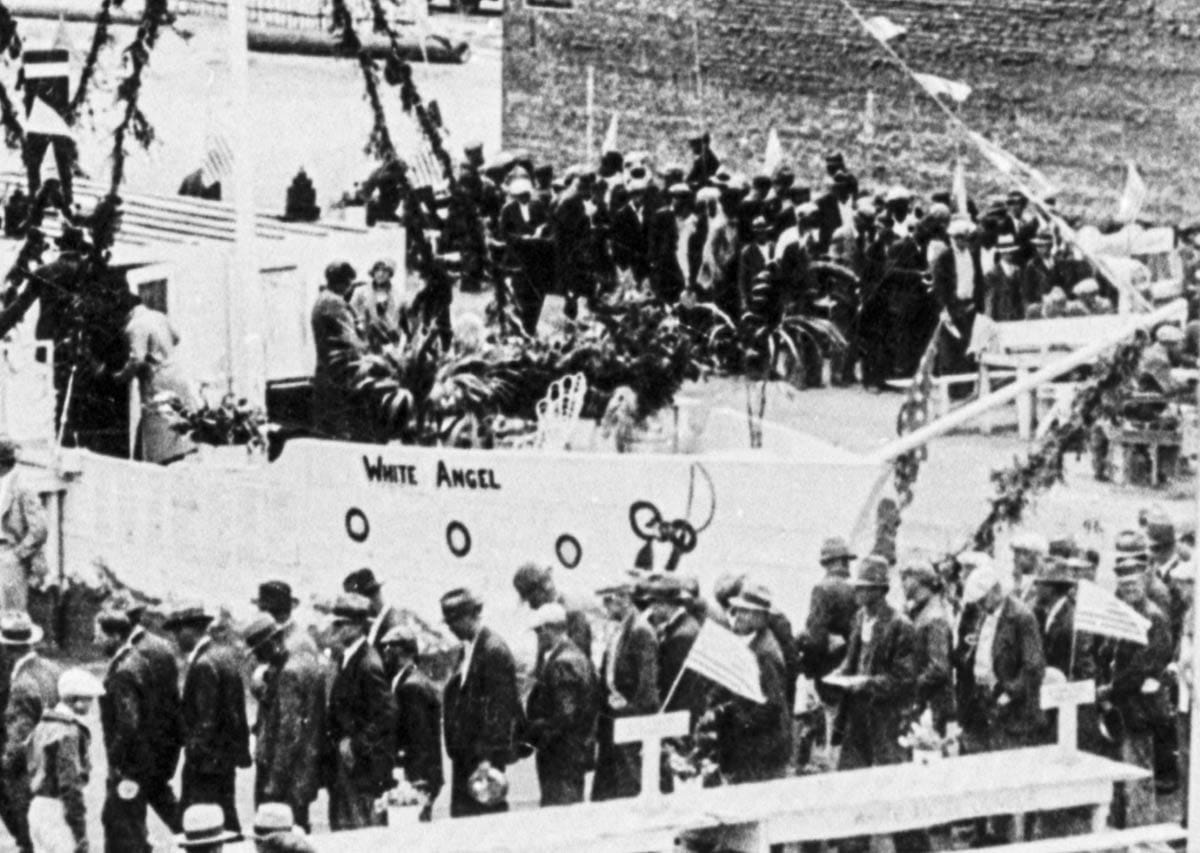
There were fake windmills and a tiny town built on top of old stables used as showers:
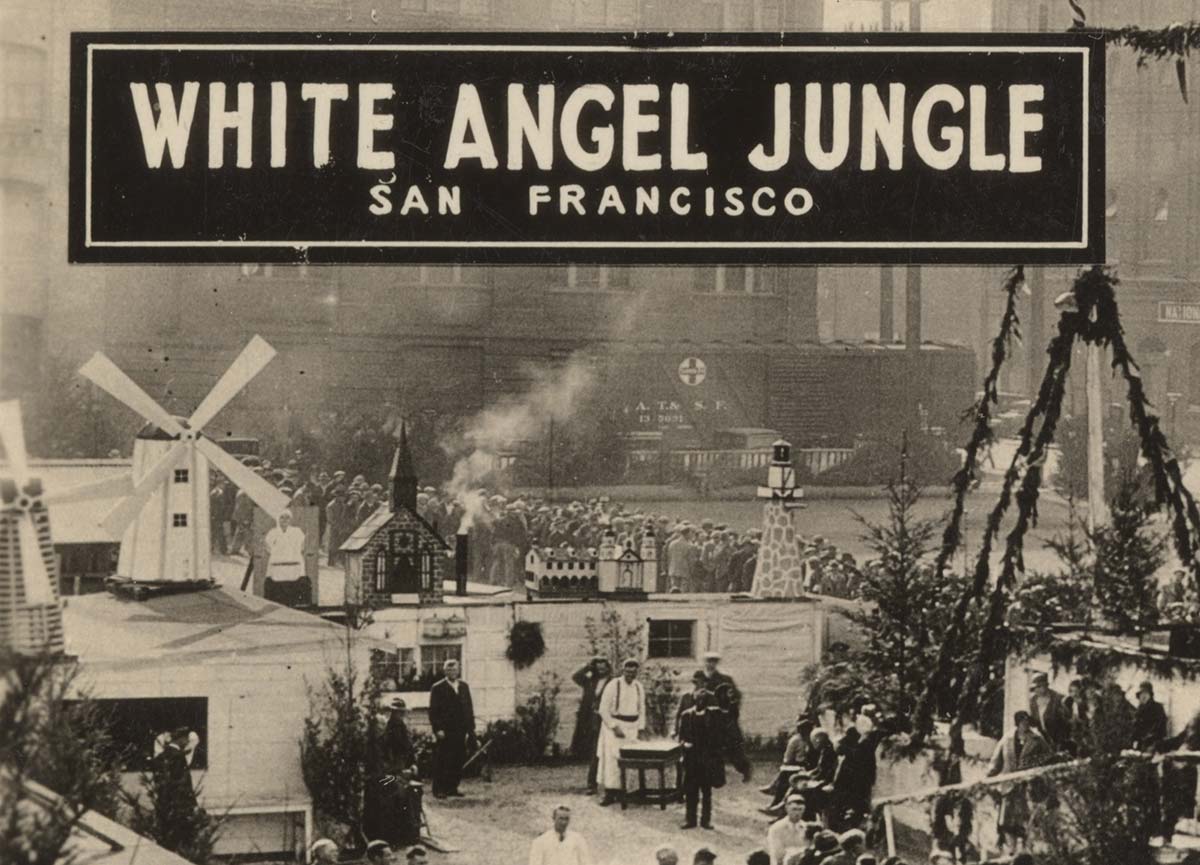
All of that, and a fish pond, were reportedly built by the grateful men at White Angel Jungle, a name, by the way, that feels like the channeling of some racist colonialism trope, Christianity being brought to darkest Africa.
It may have derived from the “Trader Horn” books, a popular 1920s series which has a story of a white woman worshiped as a goddess by a tribe along the Ogowe River in modern Gabon.
Check out this poster from the 1931 movie based on the story:
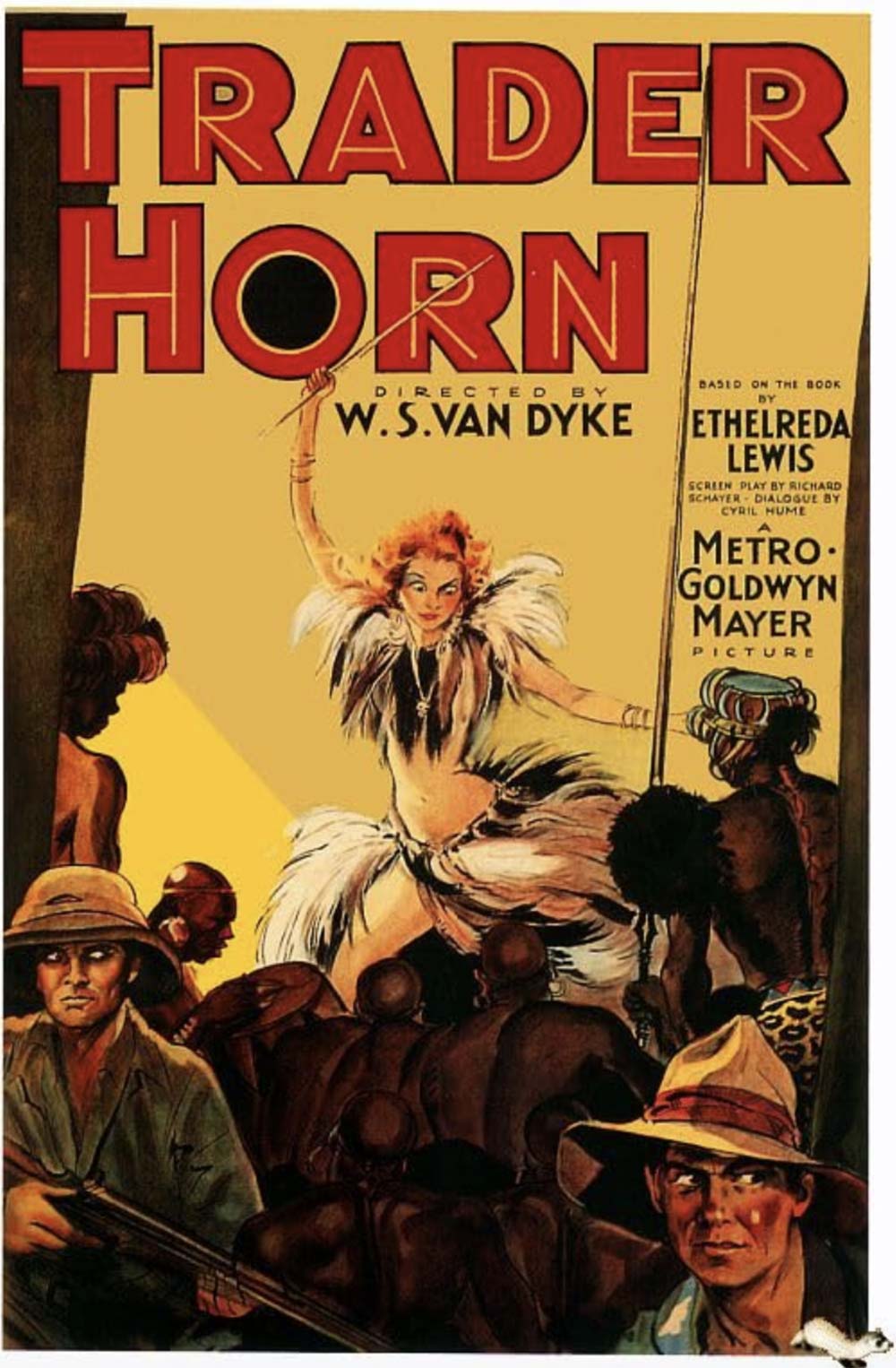
As the production of postcards implies, White Angel Jungle became a sort of short-term tourist destination. Reporters, some apparently faux hoboes, sent dispatches from the scene to as far away as Maryland with lines like “Frisco’s the only city in th’ world which ‘as such good free eats…”
Bread lines and soup kitchens were in all major cities in the dark days of the Depression. In 1931, New York City had 82 of them feeding 85,000 meals each day. But the others didn’t have the white angel enthusiastically pitching overcoats to a crowd.
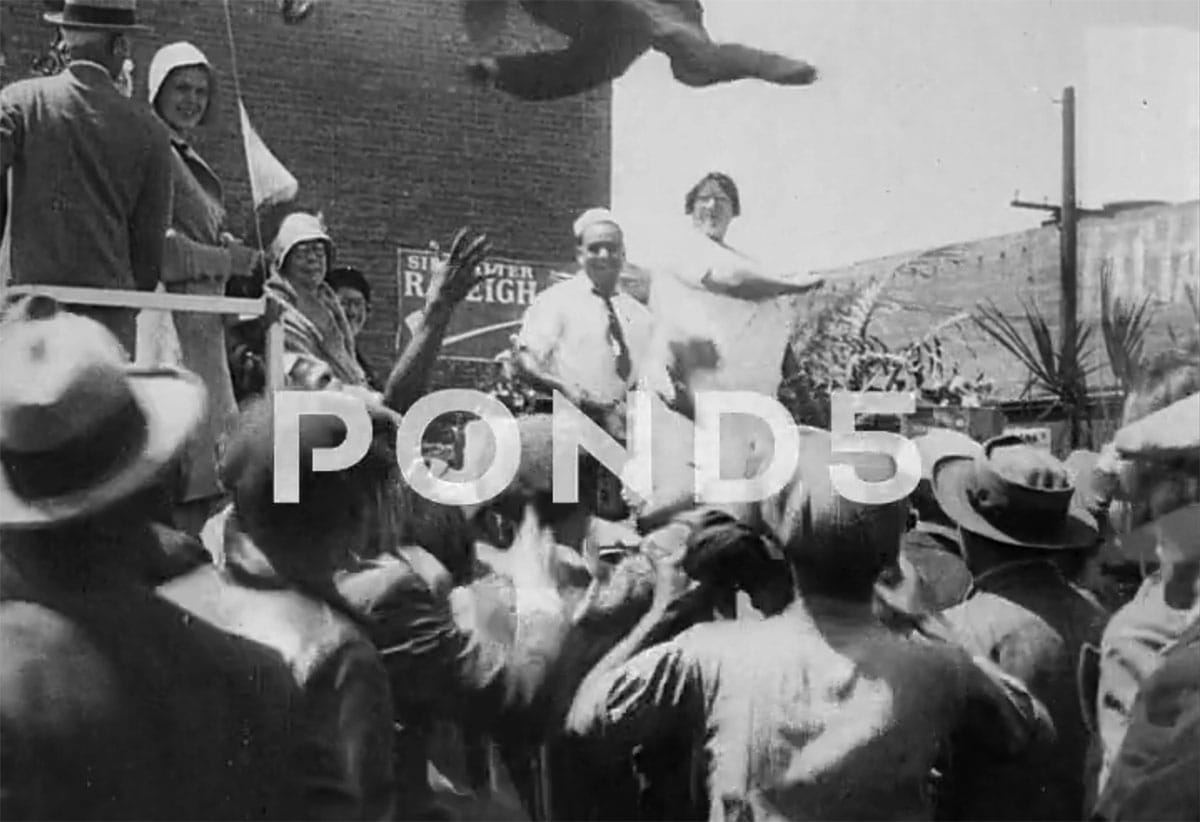
Although Jordan said she didn’t want to be called the White Angel, between her own theater and what the press created she played the role: mother, nurse, caregiver, paragon of female charity. In came donations of food, clothing, shoes, and money for the cause.
The establishment liked the production and supported it because Jordan did not shame, did not blame. She got San Francisco symphony musicians to play for the men while they ate. Farmers dropped off food each day and society matrons brought clothing.
“If you care to send a check,” she wrote in a published letter to the editor for the Stockton Daily Evening Record, “you can make it payable to ‘White Angel Jungle.’”
And if Jordan didn’t judge, her soup kitchen/art installation at White Angel Jungle was rich material for others to do so. Here was a Great Depression reality show, a play with a provocative name and a leading lady.
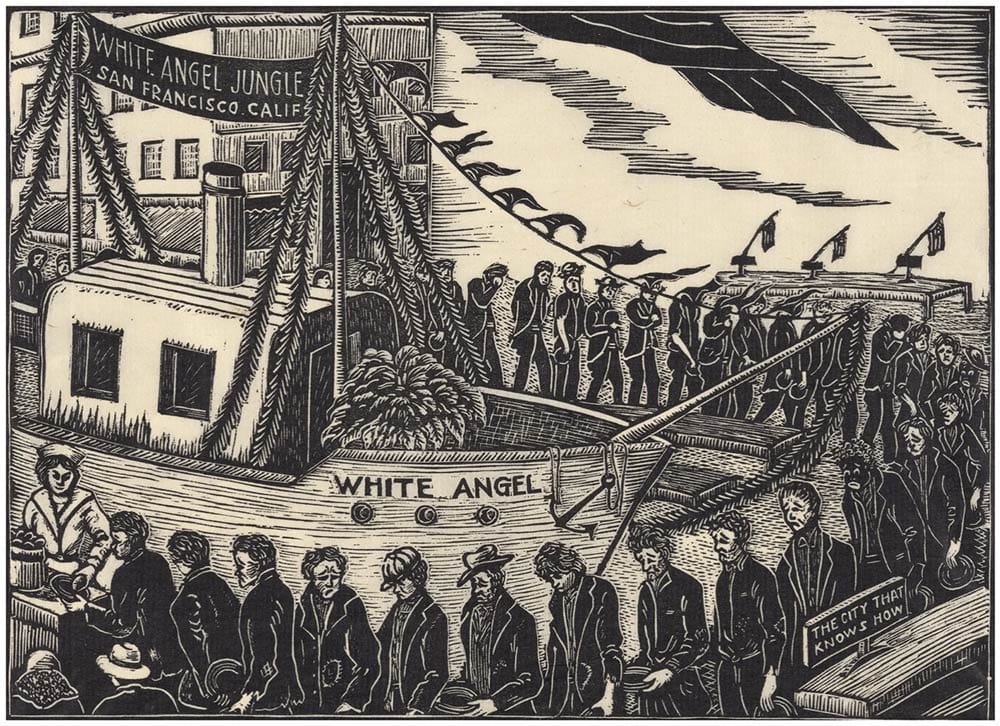
It was not new for bread lines to be wielded by the activist and by the artist. In 1902, William Dean Howells wrote about the attraction of a famous one in New York City:
“Connoisseurs of such matters, young newspapermen trying to make literature out of life and smuggle it into print under the guard of unwary editors, and young authors eager to get life into their literature, had recommended it…”
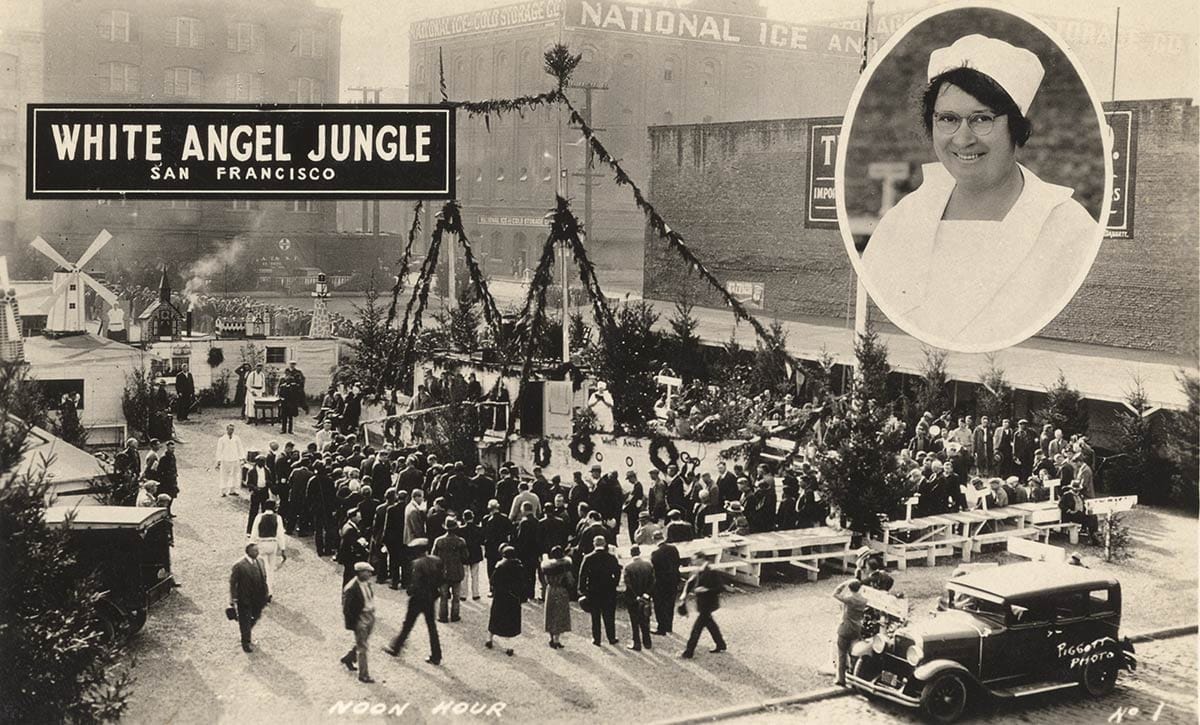
When people talk about the importance of history, they talk about how the past gives context to understand our own times, to learn, and to hopefully craft better futures from the education.
I am not sure what lesson Lois Jordan’s White Angel Jungle gives us today. As with any creative act, with anything put on stage for public review, it is easy to criticize and to deconstruct and to undervalue the impact on the audience of its day.
Does charity works best as a play, as a show, putting the needy onstage? Do we need the celebrities and the characters to inspire? It may be a matter of individual taste, like all art.
The simpler takeaway may be that one person can make a difference, so quit trying to find themes and go feed some people.
Carville Show on Sunday, June 23, 2024

I am returning to the great 4 Star Theater, 2200 Clement Street, on Sunday afternoon, June 23, 2024, at 1:00 p.m. to give a presentation on one of my favorite San Francisco Stories. Get your ticket today!
Woody Beer and Coffee Fund

Great thanks to Catherine K. for her donation to the relaxation reserves, the social slush fund, the “I’ve got this” account that spurs me to slow down and have a drink with someone. Is it your turn to chip in? Or maybe it’s your turn to have a beer or coffee or kombucha with me? Let me know when you’re free.
Sources
“White Angel Rules Jungle on Waterfront,” San Francisco Chronicle, April 26, 1931, pg. 4.
“White Angel’s Jungle Camp Celebrates Birthday of Founding,” San Francisco Chronicle, June 13, 1932, Second Section, pg. 1.
Esto Broughton, “Rambling Around,” Stockton Daily Record, August 19, 1932.
“Tells of Recent Trip to West and Northwest,” The Daily News (Frederick, Maryland), August 30, 1932, pg. 2.
“Letters from the People,” Stockton Daily Evening Record, November 17, 1932, pg. 9.
Terry Donoghue, “Terry Gets Fresh Outfit and New Outlook,” Buffalo Times, December 14, 1932, pg. 11.
‘The Voyageur,’ “Grift Good, Hobo Finds On 12-Hour Visit to S.F.,” San Francisco Chronicle, January 8, 1933, pg. 9.
Tim Couzens, Tramp Royal: the True Story of Trader Horn (Johannesburg: Ravan Press, Witwatersrand University Press, 1992)
Pizer, Donald. “The Bread Line: An American Icon of Hard Times.” Studies in American Naturalism, vol. 2, no. 2, 2007, pp. 103–28.
John Freeman, “Lois Jordan The Shadowy White Angel,” San Francisco Bay Area Post Card Club newsletter, November 2008, pg. 8. (Link to PDF to download)
Gary Kamiya, “Mother of the White Angel Jungle,” Alta Online (August 2, 2021)

